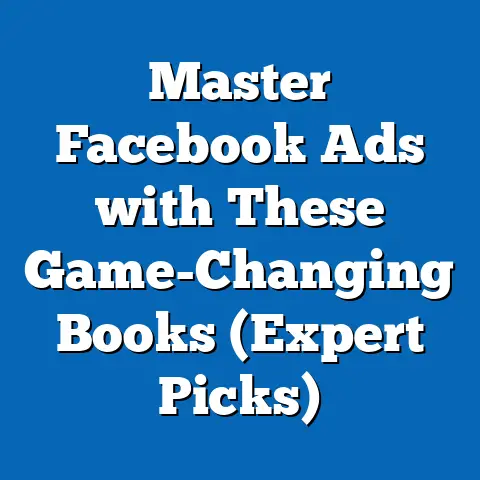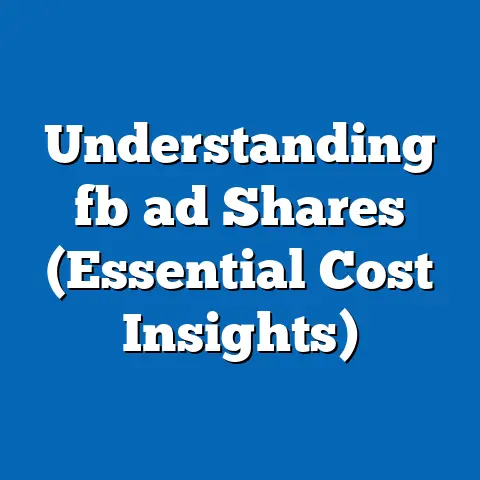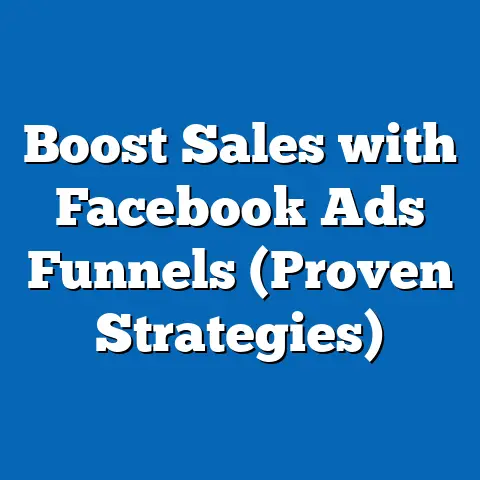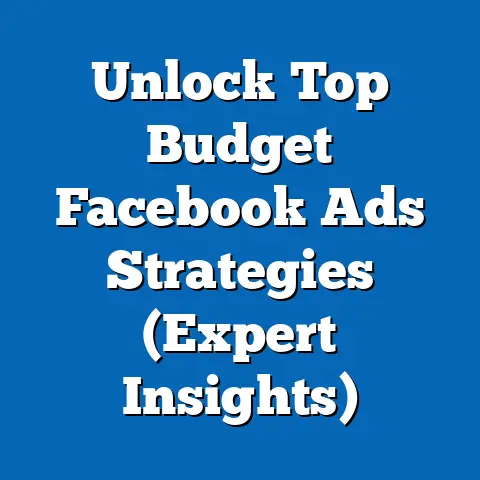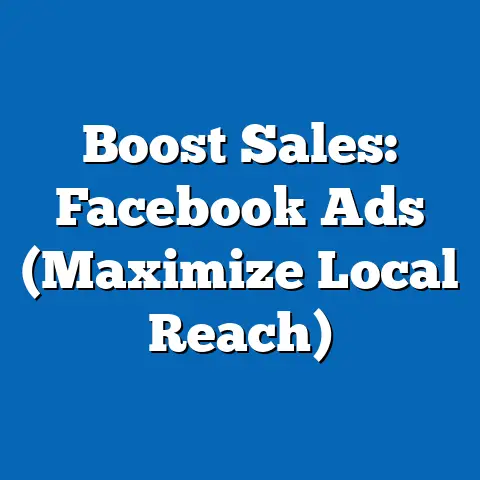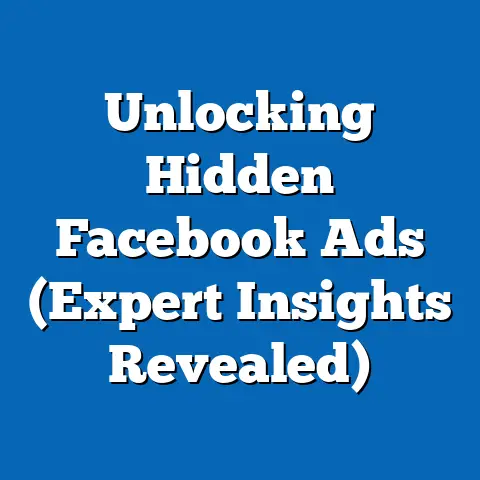Customize Facebook Ads for Maximum Impact (Expert Strategies)
I remember when I first started running Facebook ads. I thought it was as simple as throwing up a pretty picture and a catchy slogan. Boy, was I wrong! My early campaigns were a colossal waste of money, delivering impressions but zero results. It wasn’t until I truly understood the power of customization and targeted messaging that I started seeing a real return on my investment.
Facebook advertising, when done right, isn’t just about selling products; it’s about connecting people with solutions that genuinely improve their lives. Think about it: that targeted ad you saw that led you to discover a new hobby, a life-changing fitness program, or a tool that streamlined your work process – that’s the power of effective advertising. It’s about finding the right people, at the right time, with a message that resonates. We’re not just pushing products; we’re offering a lifestyle upgrade.
The key to unlocking this potential lies in customization. Generic ads are easily ignored, lost in the sea of content that floods our Facebook feeds daily. But a well-crafted ad, tailored to a specific audience with a message that speaks directly to their needs and desires, has the power to cut through the noise and make a real impact. In this guide, I’m going to share the expert strategies I’ve learned over the years to help you customize your Facebook ads for maximum impact and help your audience achieve their own lifestyle upgrades.
Understanding Your Audience
Audience segmentation is the bedrock of successful Facebook advertising. Imagine trying to sell snow shovels to people living in Hawaii – it’s a mismatch, right? That’s why understanding your audience is so crucial. It’s about identifying the different groups within your potential customer base and crafting messages that speak directly to their unique needs, interests, and pain points.
One of my favorite tools for this is Facebook Audience Insights. This free tool provides a wealth of data on your potential audience, including demographics (age, gender, location, education), interests, behaviors, and even page likes. It’s like having a backstage pass to the minds of your target customers!
Beyond Audience Insights, don’t underestimate the power of good old-fashioned customer surveys. Asking your existing customers about their motivations, challenges, and preferences can provide invaluable insights. I’ve found that offering a small incentive, like a discount or a free gift, can significantly increase response rates.
And don’t forget to analyze your existing customer data. Your CRM, website analytics, and social media engagement metrics can all provide clues about who your customers are and what they’re looking for. Look for patterns and trends that can inform your audience segmentation strategy.
The ultimate goal is to create buyer personas – fictional representations of your ideal customers. These personas should be based on real data and insights, and they should include details like demographics, interests, motivations, pain points, and even their preferred communication style. By creating these personas, you can develop ads that resonate with specific audience segments on a deeper level. For example, let’s say you’re selling organic skincare. You might have one persona, “Eco-Conscious Emily,” who is a young professional deeply concerned about the environment and looking for sustainable beauty solutions. Another persona could be “Busy Mom Brenda,” who prioritizes quick and effective skincare routines using natural ingredients. Tailoring your ads to these specific personas will significantly increase your chances of success.
Key Takeaway: Understanding your audience is paramount. Use Facebook Audience Insights, customer surveys, and existing data to create detailed buyer personas that will guide your ad customization efforts.
Crafting Compelling Ad Copy
Now that you understand your audience, it’s time to craft ad copy that grabs their attention and compels them to take action. Remember, you only have a few seconds to make an impression, so your words need to be powerful and persuasive.
One of the most important elements of persuasive ad copy is clarity. Your message should be easy to understand and immediately convey the value proposition. Avoid jargon or overly technical language that might confuse your audience.
Another key element is emotional appeal. People are more likely to respond to ads that evoke emotions, whether it’s excitement, happiness, fear, or even anger. Consider how you can tap into your audience’s emotions to create a stronger connection. For “Eco-Conscious Emily,” you might highlight the sustainable sourcing of your ingredients and the positive impact on the environment. For “Busy Mom Brenda,” you might focus on the time-saving benefits and the peace of mind that comes with using safe, natural products.
Finally, don’t forget the urgency. Creating a sense of scarcity or time-sensitivity can encourage people to take action sooner rather than later. Use phrases like “Limited Time Offer,” “While Supplies Last,” or “Sale Ends Soon” to create a sense of urgency.
Your headline is the first thing people will see, so it needs to be attention-grabbing and make a strong connection with their desires or pain points. Ask yourself: what problem are you solving for your audience? What benefit are you offering? Use your headline to communicate that value proposition clearly and concisely. For example, instead of saying “Organic Skincare Products,” you might say “Get Glowing Skin Naturally – Without Harmful Chemicals!”
And of course, every ad needs a strong call-to-action (CTA). Your CTA should tell people exactly what you want them to do, whether it’s “Shop Now,” “Learn More,” “Sign Up,” or “Get a Free Quote.” Make your CTA clear, concise, and visually prominent. A/B test different CTAs to see which performs best. I once ran a campaign where simply changing the CTA from “Learn More” to “Discover the Secret” resulted in a 30% increase in click-through rates.
Key Takeaway: Craft compelling ad copy that is clear, emotionally appealing, and creates a sense of urgency. Use a strong headline to grab attention and a clear call-to-action to drive engagement and conversions.
Visual Elements that Captivate
In the world of Facebook advertising, visuals are king. A captivating image or video can stop people in their tracks and draw them into your message. Think about it: how many times have you scrolled past an ad simply because the visual didn’t catch your eye?
Your visuals should align with your brand and resonate with your target audience. Use high-quality images or videos that are visually appealing and relevant to your message. Avoid using stock photos that look generic or inauthentic. Invest in professional photography or videography if possible.
For “Eco-Conscious Emily,” you might use images of lush green forests or close-ups of your sustainably sourced ingredients. For “Busy Mom Brenda,” you might use images of happy, relaxed moms enjoying their skincare routine.
A/B testing different visual elements is crucial for determining which performs best. Try testing different images, videos, and even different color schemes. Pay attention to the metrics that matter most to your business, such as click-through rate, conversion rate, and cost per acquisition. I once ran a campaign where simply changing the background color of an image resulted in a 20% increase in conversions.
Don’t underestimate the power of video. Video ads are highly engaging and can be used to tell a story, showcase your product, or provide valuable information. Keep your videos short and sweet, and make sure to include captions for viewers who might be watching with the sound off. I’ve found that short, attention-grabbing videos that are under 15 seconds tend to perform best on Facebook.
Key Takeaway: Visuals are crucial for capturing attention and conveying your message. Choose high-quality images or videos that align with your brand and resonate with your target audience. A/B test different visual elements to optimize performance.
Leveraging Facebook Ad Formats
Facebook offers a variety of ad formats, each with its own strengths and weaknesses. Choosing the right ad format can significantly impact the success of your campaign.
Carousel ads allow you to showcase multiple images or videos in a single ad unit. This format is great for showcasing different products, highlighting different features of a single product, or telling a story. I’ve found that carousel ads are particularly effective for e-commerce businesses.
Video ads are highly engaging and can be used to tell a story, showcase your product, or provide valuable information. As I mentioned earlier, keep your videos short and sweet, and make sure to include captions.
Slideshow ads are a great option if you don’t have the budget for video production. You can create a slideshow ad using a series of still images. Facebook will automatically animate the images to create a visually appealing experience.
Collection ads are designed to showcase your products in a visually immersive format. This format is great for e-commerce businesses looking to drive sales.
The best ad format for you will depend on your marketing goals and your target audience. Experiment with different ad formats to see which performs best for your business.
Key Takeaway: Facebook offers a variety of ad formats, each with its own strengths and weaknesses. Choose the right ad format based on your marketing goals and target audience.
Utilizing Advanced Targeting Options
Facebook’s advanced targeting options allow you to reach users who are more likely to convert, thus maximizing the impact of your ads.
Lookalike audiences allow you to target users who are similar to your existing customers. This is a great way to expand your reach and find new customers who are likely to be interested in your products or services. I’ve found that lookalike audiences based on website visitors or email subscribers tend to perform best.
Custom audiences allow you to target users based on your own data, such as email lists, website visitors, or app users. This is a great way to re-engage with existing customers or target users who have shown interest in your products or services.
Detailed targeting allows you to target users based on their demographics, interests, behaviors, and more. This is a great way to fine-tune your targeting and reach a specific audience. For example, you could target women aged 25-34 who are interested in organic skincare and live in California.
By combining these advanced targeting options, you can create highly targeted campaigns that are more likely to convert.
Key Takeaway: Facebook’s advanced targeting options allow you to reach users who are more likely to convert. Use lookalike audiences, custom audiences, and detailed targeting to fine-tune your targeting and maximize the impact of your ads.
Analyzing and Optimizing Ad Performance
Monitoring ad performance metrics is crucial for making data-driven decisions and optimizing your campaigns for maximum impact.
Some of the most important metrics to track include:
- Click-through rate (CTR): The percentage of people who click on your ad after seeing it.
- Conversion rate: The percentage of people who take a desired action (e.g., make a purchase, sign up for a newsletter) after clicking on your ad.
- Engagement rate: The percentage of people who interact with your ad (e.g., like, comment, share).
- Cost per click (CPC): The average cost you pay each time someone clicks on your ad.
- Cost per acquisition (CPA): The average cost you pay for each conversion.
By tracking these metrics, you can identify areas where your ads are performing well and areas where they need improvement.
For example, if your CTR is low, it could mean that your ad copy or visuals are not compelling enough. If your conversion rate is low, it could mean that your landing page is not optimized for conversions.
Based on your performance insights, you can adjust your ad strategies to improve results. This might involve changing your ad copy, visuals, targeting, or even your ad format.
Key Takeaway: Monitoring ad performance metrics is crucial for making data-driven decisions and optimizing your campaigns. Track key metrics like CTR, conversion rate, engagement rate, CPC, and CPA, and adjust your ad strategies based on your performance insights.
Conclusion
Customizing Facebook ads is essential for achieving maximum impact and helping your audience achieve their own lifestyle upgrades. By understanding your audience, crafting compelling ad copy, using captivating visuals, leveraging Facebook ad formats, utilizing advanced targeting options, and analyzing and optimizing ad performance, you can create campaigns that resonate with your target audience and drive significant business growth.
Don’t be afraid to experiment and try new things. The world of Facebook advertising is constantly evolving, so it’s important to stay up-to-date on the latest trends and best practices.
So, take action today and start customizing your Facebook ads for maximum impact. The right approach to Facebook ads can lead to meaningful connections with your audience and significant business growth, ultimately enhancing your lifestyle and the lives of those you serve. Remember, it’s not just about selling; it’s about connecting people with solutions that genuinely improve their lives!

